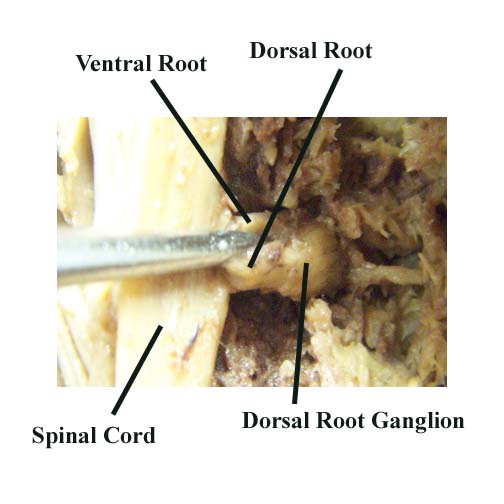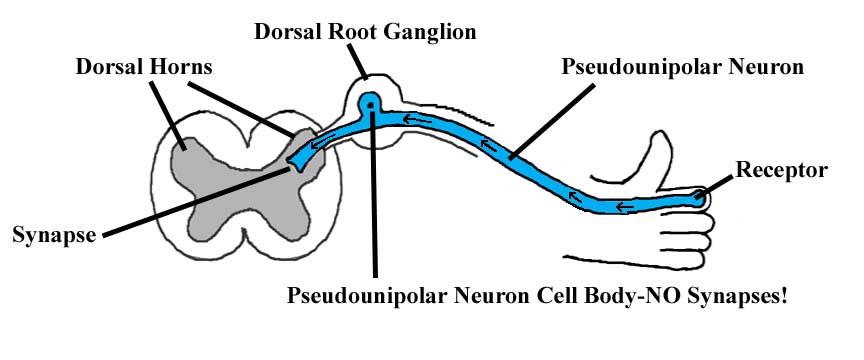 Emerging from the dorsal and ventral horns of the spinal cord are dorsal and ventral rootlets, respectively. These rootlets carry nerve fibers both toward and away from the spinal cord. The dorsal rootlets carry sensory (afferent) fibers to the spinal cord, and ventral rootlets carry motor (efferent) fibers away from the spinal cord. Laterally, near each intervertebral foramen, a number of dorsal rootlets coalesce into a single dorsal root, and a number of ventral rootlets coalesce into a single ventral root. These roots then leave the vertebral canal to lie within the intervertebral foramen. There, the dorsal and ventral roots fuse to form the spinal nerve, which is a mixed nerve carrying both sensory and motor fibers.
Emerging from the dorsal and ventral horns of the spinal cord are dorsal and ventral rootlets, respectively. These rootlets carry nerve fibers both toward and away from the spinal cord. The dorsal rootlets carry sensory (afferent) fibers to the spinal cord, and ventral rootlets carry motor (efferent) fibers away from the spinal cord. Laterally, near each intervertebral foramen, a number of dorsal rootlets coalesce into a single dorsal root, and a number of ventral rootlets coalesce into a single ventral root. These roots then leave the vertebral canal to lie within the intervertebral foramen. There, the dorsal and ventral roots fuse to form the spinal nerve, which is a mixed nerve carrying both sensory and motor fibers.
Along the dorsal roots, lateral to the spinal cord and just medial to fusing with ventral roots, are the dorsal root ganglia, tucked in the intervertebral foramina. Recall that a ganglion is a collection of neuron cell bodies in the peripheral nervous system. The dorsal root ganglia (sometimes called the spinal ganglia) contain the cell bodies for the peripheral sensory nerve fibers. The sensory peripheral neurons have an unusual and unique structure. Sensory peripheral neurons are called pseudounipolar neurons because the cell body sits above the neuronal process, which extends in both directions (see diagram). It is very difficult to define the nerve process as an axon or dendrite because the cell is not arranged as a typical neuron. Some texts refer to the nerve process of a pseudounipolar neuron as an "axonodendrite," however usually you will hear it called simply a nerve process. The receptors for the pseudounipolar neurons are located in the skin, subcutaneous tissue, deep tissue or viscera and the nerve process synapses in the dorsal horn of the spinal cord. The cell bodies sit in the dorsal root ganglia and support the neurons. It is very important to recognize that there are NO synapses in the dorsal root ganglia! This is a very common point of confusion, but if you realize that the nerve process runs straight from the receptor all the way into the dorsal horn and that the cell body is sitting in the dorsal root ganglia solely to support the neuron, you should stay out of trouble. Again, there are no synapses in the dorsal root ganglia!
 |






 Emerging from the dorsal and ventral horns of the spinal cord are dorsal and ventral rootlets, respectively. These rootlets carry nerve fibers both toward and away from the spinal cord. The dorsal rootlets carry sensory (afferent) fibers to the spinal cord, and ventral rootlets carry motor (efferent) fibers away from the spinal cord. Laterally, near each intervertebral foramen, a number of dorsal rootlets coalesce into a single dorsal root, and a number of ventral rootlets coalesce into a single ventral root. These roots then leave the vertebral canal to lie within the intervertebral foramen. There, the dorsal and ventral roots fuse to form the spinal nerve, which is a mixed nerve carrying both sensory and motor fibers.
Emerging from the dorsal and ventral horns of the spinal cord are dorsal and ventral rootlets, respectively. These rootlets carry nerve fibers both toward and away from the spinal cord. The dorsal rootlets carry sensory (afferent) fibers to the spinal cord, and ventral rootlets carry motor (efferent) fibers away from the spinal cord. Laterally, near each intervertebral foramen, a number of dorsal rootlets coalesce into a single dorsal root, and a number of ventral rootlets coalesce into a single ventral root. These roots then leave the vertebral canal to lie within the intervertebral foramen. There, the dorsal and ventral roots fuse to form the spinal nerve, which is a mixed nerve carrying both sensory and motor fibers. 